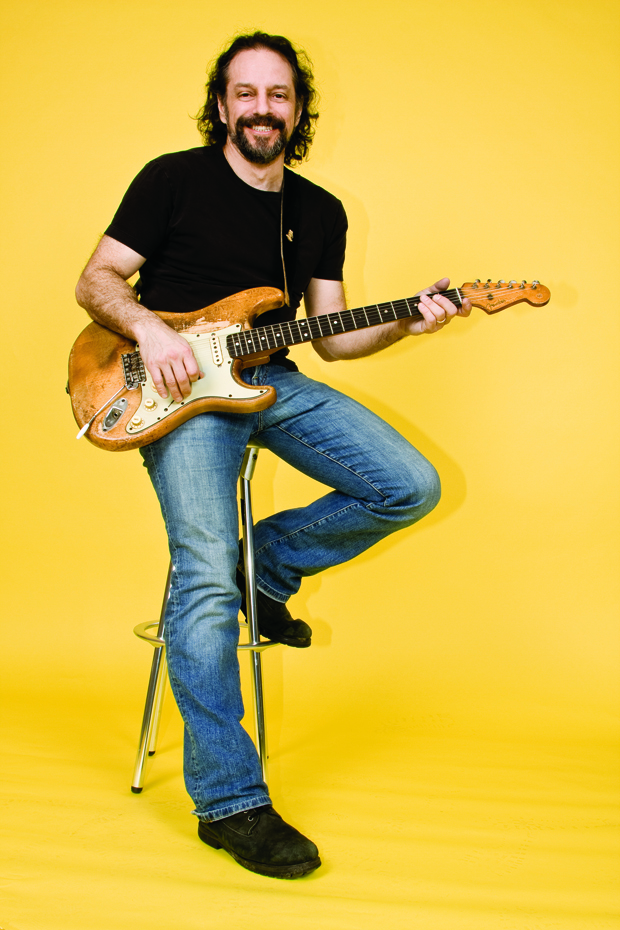In Deep with Andy Aledort: Using Voice Leading and Close Voicings to Devise Improvised Rhythm Guitar Parts — Video

Part of my role as a member of former Allman Brothers Band guitarist Dickey Betts’ band, Great Southern (along with his son, guitarist Duane Betts), is to provide improvised rhythm guitar parts to songs that oftentimes develop into long jams with many instrumental solos.
In this type of musical environment, it’s essential for the rhythm guitars to keep the accompaniment interesting and moving forward while also laying down a solid groove for the soloists to play over.
Many of these songs—like “Blue Sky,” “In Memory of Elizabeth Reed” and “No One Left to Run With”—feature soloing sections built upon repeating chord vamps.
In this endeavor, I have developed a rhythm guitar approach that I can use in any of these jamming-type situations, which is to explore small chord voicings that connect to one another via voice leading techniques, such as close voicing.
Voice leading is a harmonic device wherein individual chord tones, or “voices” that make up a chord, move minimally from chord to chord in a progression. This facilitates the connecting of chord shapes in a smooth and seamless manner on the fretboard. Close harmony is defined as “the arrangement of the notes of a chord within a narrow range,” such as the containment within one octave of the three notes that form a triad, for example, the notes A, C# and E of an A major triad. If moving from an A major triad to E major (E G# B), one can employ both techniques by moving the A note down one fret to G# and the C# down two frets to B while keeping the E where it is—as a common tone—to sound the notes G#, B and E, which results in an E major triad in first inversion, which is with the third, G#, on the bottom, or “in the bass.”
These days, Dickey likes to begin “Blue Sky” with a three-chord jam that is intended as a tribute to the Grateful Dead and his good friend Jerry Garcia, reminiscent of the Dead classic, “Franklin’s Tower.” The Dead original is in the key of A, and the three chords are, A, G and D. Dickey plays “Blue Sky” in G so, transposed down a whole step, the chords are G, F and C. The original Allman Brothers Band arrangement and recording of “Blue Sky,” however, was in the key of E; transposing the chords down another step and a half results in an E-D-A progression, which is that used in the following examples.
FIGURES 1 and 2 offer two approaches to playing the repeating two-bar rhythm vamp four times across eight bars. In FIGURE 1, I begin with a first-inversion E triad (voiced, low to high, G# B E), initiated with a hammer-on on the D string from the second, F# to the third, G#, sounded together with the open low E string. The three fretted notes then move down a whole step to a first-inversion D triad (low to high, F# A D) with the D root note octave doubled on the A string’s fifth fret. I then transition to the A triad by moving the F# note down two frets to E and D down one fret to C# while keeping the A note on the G string. Across the last four bars, the concept is moved up higher on the fretboard and over to the A, D and G strings. Use alternate (down-up) 16th-note “pendulum” strumming throughout this figure in order to perform the 16th-note rhythms with the proper, desired feel.
These devices are expanded on in FIGURE 2, so work through this example slowly with attention paid to the way in which each chord shape connects to the next.
Get The Pick Newsletter
All the latest guitar news, interviews, lessons, reviews, deals and more, direct to your inbox!
Guitar World Associate Editor Andy Aledort is recognized worldwide for his vast contributions to guitar instruction, via his many best-selling instructional DVDs, transcription books and online lessons. Andy is a regular contributor to Guitar World and Truefire, and has toured with Dickey Betts of the Allman Brothers, as well as participating in several Jimi Hendrix Tribute Tours.


